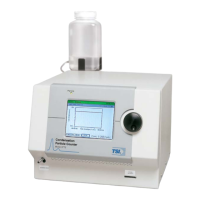3-4 Model 3775 Condensation Particle Counter
RS-232 Serial Connections
The Model 3775 CPC provides two standard 9-pin RS-232 serial
ports that allow communication between a computer and the CPC.
Serial commands are sent to and from the computer to monitor
instrument status information, to retrieve and monitor data, and to
provide a variety of control functions such as turning the pump on
and off (Serial 1 only). Aerosol Instrument Manager software may be
used with Serial 1 as well as USB. Information on RS-232
communications can be found in Chapter 7, “
Computer Interfaces
and Commands”.
Analog Inputs
The CPC can monitor the analog voltages from two external sources
via the analog input BNC connectors on the back panel, labeled
Analog Input 1 and Analog Input 2. The input voltage range for
these ports is 0 to 10 volts. Analog voltages can be displayed
together with concentration data on the LCD display and saved to
the removable Flash Memory Card or a computer. Voltages from
pressure, flow, or temperature transducers can be correlated to
particle concentration in real time.
Amplification must be supplied by the user to bring low voltage
signals to the appropriate 0 to 10 volt range for best resolution.
DMA/Analog Output and Pulse Output
DMA/Analog Output is configured by the Aerosol Instrument
Manager software to provide the ramped voltage signal needed
when the CPC is used as part of the Scanning Mobility Particle
Sizer
TM
(SMPS
TM
) spectrometer. During normal operation of the CPC
(standalone, not used as part of an SMPS), this port provides an
analog 0–10 V signal proportional (linear or log) to particle
concentration. This particle concentration is corrected for
coincidence and equals the displayed concentration. See more
details in
Chapter 4.
Pulse Output provides a 5-volt (50-ohm termination) digital pulse
for each particle detected. This enables you to use your own
counting electronics hardware and provides a particle trigger for
special applications. The width of the pulse depends on both the
shape of the photodetector pulse and the trigger-level of the pulse
threshold. Typical (nominal) pulse widths are 2.5 microseconds (see
Figure 3-3) for the 3775 CPC. To provide accurate pulse counts, use
a counter that is capable of counting pulses with a width of 50
nanoseconds or less.

